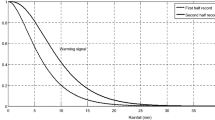Abstract
The increase in the average temperature in the lower atmosphere caused by climate change triggers changes in various elements of the hydrological cycle at different scales depending on location in the world. Although numerous published studies are concerned with the effect of climate change on hydrological elements such as temperature, precipitation, evaporation, wind, and runoff, unfortunately, the performance of water engineering structures is not taken into consideration. Nevertheless, as an integral part of the whole water resources systems, engineering structures such as dams, canals, culverts, and wells are also subject to climate change impacts. This examines the performance of engineering structures by taking into account how climate change impacts on the risk assessment formulation. For this purpose, the risk concept is redefined and the climate change impact is taken into account by a factor dependent on the positive or negative slope of the trend from the historical record. The risk levels are revised for 10-year, 50-year, and 100-year return periods. The application of the proposed methodology is given for precipitation records for three different meteorological stations in the southeastern European province of Turkey and for the same number of stations from central east-west belt over Saudi Arabia. It is observed that including the climate change factor in the risk calculation formulation generally leads to an increase in the return period and in the risk compared to conventional calculations. Therefore, it is recommended that rather than using the standard risk formulation, the simple, effective climate change risk approach, as suggested in this paper, be applied to future water engineering structure designs.





Similar content being viewed by others
References
Abdulla FA, Al-Omari A (2008) Impact of climate change on the monthly runoff of semi-arid catchments: case study Zarqa River Basin (Jordan). J App Bio Sci 2(1):43–50
Almazroui M, Islam MN, Saeed F, Alkhalaf AK, Dambul R (2017) Assessing the robustness and uncertainties of projected changes in temperature and precipitation in AR5 Global Climate Models over the Arabian Peninsula. Atmos Res. https://doi.org/10.1016/j.atmosres.2017.05.005
Benjamin JR, Cornell CA (1970) Probability, statistics and decisions for civil engineers. McGraw-Hill, New York
Barnett TP, Adam JC, Lettenmaier DP (2005) Potential impacts of a warming climate on water availability in snow-dominated regions. Nat 438:303–309
Carter TR, Jones RN, Lu X, Bhadwal S, Conde C, Mearns LO, O’Neill BC, Rounsevell MCA, Zurek MB (2007) New assessment methods and the characterization of future conditions. In: Climate Change 2007: Impacts, Adaptation and Vulnerability. Contribution of Working Group II to the Fourth Assessment Report of the Intergovernmental Panel on Climate Change
Döll P, Flörke M (2005) Global-scale estimating of diffuses groundwater recharge. Frankfurt Hydrology paper 03. Institute of Physical Geography, Frankfurt
Füssel HM (2009) An updated assessment of the risks from climate change based on research published since the IPCC Fourth Assessment Report. Clim Chang 97:469–482
IPCC Report (2007a) The Fourth Assessment Report (AR4), http:/www.ippc.ch/, March 14, 2008. IPCC Report (2001) Climate Change 2001: The Scientific Basis. Contribution of Working Group I to the Third Assessment Report of the Intergovernmental Panel on Climate Change
IPCC Report (2007b) Climate Change 2007: The Physical Science Basis. Contribution of Working Group I to the Fourth Assessment Report of the Intergovernmental Panel on Climate Change. Solomon S., Qin, D., Manning, M., Chen, Z., Marquis, M., Averyt, K.B., Tignor
Jones RN (2001) An environmental risk assessment/management framework for climate change. Nat Hazar 23:197–230
Jones RN (2004a) Incorporating agency into climate change risk assessments—an editorial comment. Clim Chang 67:13–36
Jones RN (2004b) Managing climate change risks, In: The benefits of climate change policies: analytical and framework issues. Corfee Morlot, J. Agrawala, S. (eds). Organization for Economic Co-operation and Development, Paris: 251–297
Kamil S, Almazroui M, Kucharski F, Kang I (2017) Multi-decadal changes in the relationship of storm frequency over Euro-Mediterranean Region and ENSO during boreal winter. Earth Systems and Environment 1:6. https://doi.org/10.1007/s41748-017-0011-0
Rahmstorf S, Cazenave A, Church JA, Hansen JE, Keeling RF, Parker DE, Somerville RCJ (2007) Recent climate observations compared to projections. Sci 316:709
Smith RB, Foster J, Kouchoukos N, Gluhosky A, Young R, Zhang J (2000) Hydrologic trends in the Middle East: modeling and remote sensing, Yale University, E. DePauw, ICARDA
Şen Z, Uyumaz A, Cebeci M, Öztopal A, Küçükmehmetoğlu M, Özger M, Erdik T, Sırdaş S, Şahin AD, Geymen A, Oğuz S, Karsavran Y (2010) The impacts of climate change on Istanbul and Turkey water resources. Istanbul Metropolitan Municipality, Istanbul Water and Sewerage Administration, 1500 p
Şen Z, (2015) Drought modelling, prediction and mitigation. Elsevier, Amsterdam: 472 pp
Şen Z, Al Alsheikh A, Al-Turbak AS, Al-Bassam AM, Al-Dakheel AM (2011) Climate change impact and runoff harvesting in arid regions. Arab J Geosci. https://doi.org/10.1007/s12517-011-0354-z
UKCIP (2003) Climate adaptation: risk, uncertainty and decision-making. Willows, R.I., Connell, R.K. (eds). UKCIP Technical Report. UKCIP, Oxford, 166 p. Available from: http://www.ukcip.org.uk/images/stories/Pub_pdfs/Risk.pdf (Accessed 22 December 2009)
UNDP (2005) Adaptation policy frameworks for climate change: developing strategies, policies and measures. In: Lim B, Spanger-Siegfried E, Burton I, Malone E, Huq S (eds) . Cambridge University Press, Cambridge and New York 266 p
Acknowledgements
The authors are grateful to the relevant departments of Turkey and Saudi Arabia for providing precipitation data. Analyses of the data were performed on the Aziz Supercomputer at King Abdulaziz University’s High Performance Computing Center, Jeddah, Saudi Arabia.
Author information
Authors and Affiliations
Corresponding author
Rights and permissions
About this article
Cite this article
Şen, Z., Mohorji, A.M. & Almazroui, M. Engineering risk assessment on water structures under climate change effects. Arab J Geosci 10, 517 (2017). https://doi.org/10.1007/s12517-017-3275-7
Received:
Accepted:
Published:
DOI: https://doi.org/10.1007/s12517-017-3275-7




